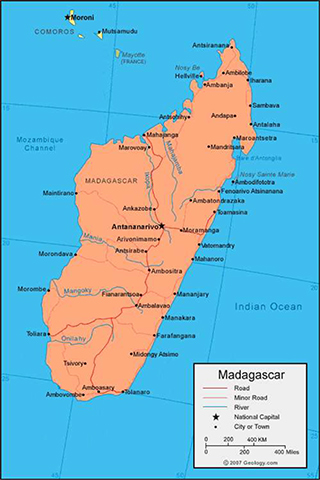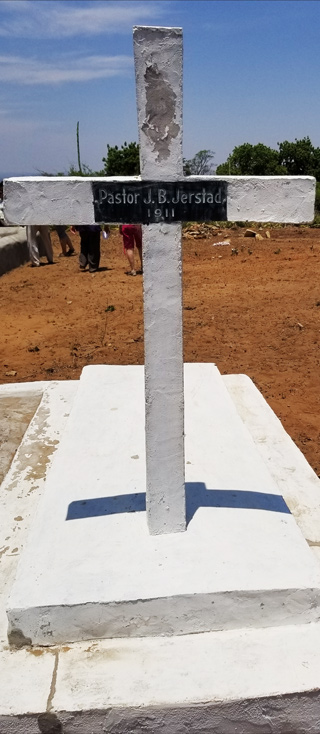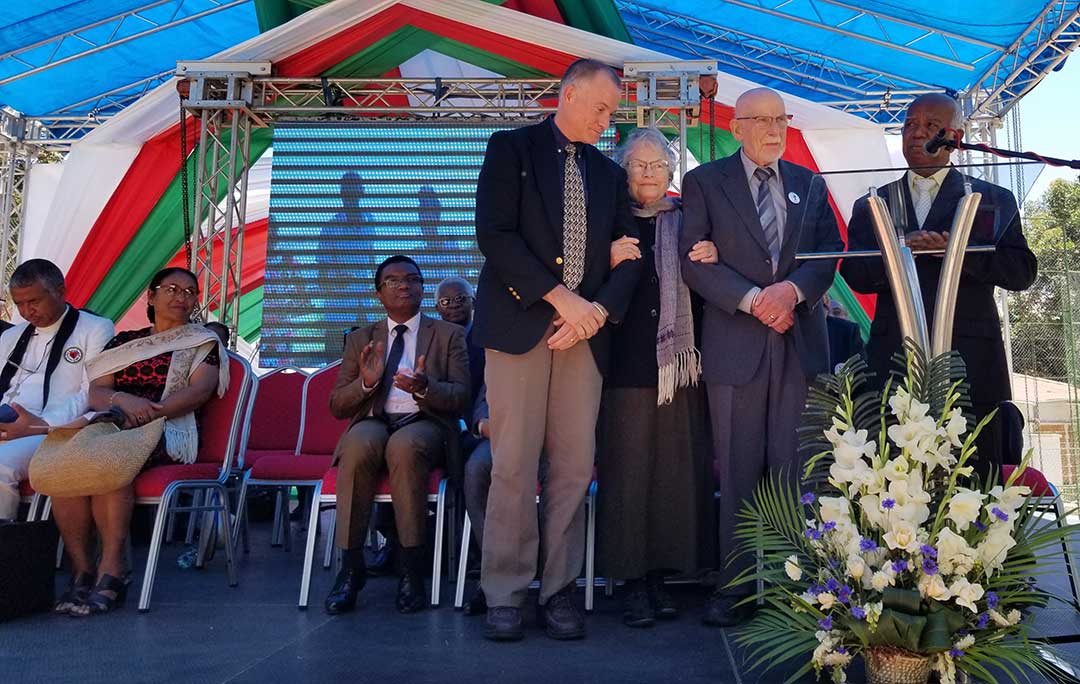
Madagascar
Lutheran missionaries in Madagascar began a time of planting the Gospel of Jesus Christ 184 years ago. From 1888 through 2010 there were 366 Lutheran missionaries from America who served in Madagascar. This equals 5,445 years of individual missionary service to help establish today’s dynamic Malagasy Lutheran Church (MLC). The average time of service for these missionaries was 14.88 years. The longest term of one missionary was 46 years.

Madagascar – global view
Near the end of the 20th century, the foreign missionary community was dwindling quickly. There was a changing role regarding who was doing the mission work in Madagascar. The Malagasy Lutheran Church (MLC), built upon the foundation that the missionaries developed, are now able to provide all of the leaders, evangelists, teachers and pastors that the church needs for its work and continuing growth. Christians from America are welcome to serve in the MLC, as they are in any church across the world, but the mission is not dependent upon them.
The missionaries understood from the beginning that they were there to plant the seed of the Christian Faith and that they had to train Malagasy people to be the pastors, evangelists and leaders of an emerging church.
They were faithful in preparing for an independent, self- governed church – the Malagasy Lutheran Church – which was formed in 1950. Missionaries continued to serve in Madagascar, but the numbers began to decline so that today there are no American missionaries serving in Madagascar (except a few in administrative relationship roles).
Today the Malagasy pastors, evangelists, teachers, medical doctors and administrators provide wonderful leadership for one of the fastest-growing Lutheran churches in the world. They also are sending missionaries to other countries. Malagasy missionaries have served in Papua New Guinea (Mamy Jocelyn Ranaivoson and Dr. Clement Ralison), Cameroun (Dr. Solofoniaina Rakotoarivelo and Dr. Joely Rakotoarivelo) and Bangladesh (Dr. Roseline and Dr. Baozandry Justine).
Honoring the Legacy of the American Missionaries
It is impossible to honor the 366 American missionaries to Madagascar with a personal story about their service. They were all faithful missionaries who came from all sections of the country, but mainly from the Upper Midwest’s small rural towns and cities with deep roots in the missionary endeavor. The interest in being a missionary came from the emphasis on global mission in every congregation. They had an annual Sunday Mission Festival; the women’s organization and Sunday school had programs and lessons about global mission. Congregations supported a missionary and received letters and visits from the missionaries to create a close, personal connection. Many children grew into adulthood with the dream of someday being a missionary.
There are many interesting stories about these missionaries. Also, some of these missionaries came from multiple family generations of missionaries such as the Braaten, Dyrud, Quanbeck, Stolee, Toso and Vaagenes families. They all deserve to have their stories told, but for this article we tell the missionary story of the Dr. Stanley and Katharine Quanbeck family.
Quanbeck/Jerstad Family Tree of Missionaries
Both of Dr. Stanley Quanbeck’s parents, Caleb and Constance (Connie) were missionaries in Madagascar. We begin Dr. Quanbeck’s story with the mission story of his parents.
Dr. Stanley Quanbeck’s Father: Rev. Caleb and Constance Quanbeck – served as missionaries in Madagascar 1926-1980
Caleb Quanbeck attended Augsburg College and Seminary. He was a farm boy from a ranch in Montana. His father was a pastor in the Lutheran Free Church in Shepherd, Montana. After the completion of Caleb’s seminary studies, Caleb and Connie were married and went to France to study French. Caleb would be responsible to direct a mission school under the French colonial regime. After spending a year and a half in Paris, Caleb received his Diploma in the French language enabling him to be a director of a mission school. They arrived in Manasoa in 1928.

Connie Quanbeck was in charge of a girl’s home at Manasoa in 1932
Their daughter, Hortense, was born in Manasoa in 1934. In 1937, their son, Stanley, was born in Minneapolis, Minnesota, while on furlough. During the war years from 1939 to 1945 they remained in Manasoa, and during part of those years the two children were in boarding school in Fort Dauphin, 200 miles to the southeast. On May 10, 1944, Hortense died of malaria while at the boarding school. Stanley eventually graduated from the American School for American Missionary children located in Fort Dauphin in 1954.
Caleb and Connie continued their work as missionaries in Madagascar and retired in the 1970s in Madagascar. Connie died in 1978 and is buried alongside her daughter, Hortense, in the American Lutheran Cemetery at Fort Dauphin. Caleb fully retired in 1980 and returned to his homeland of Montana, where he died in 1990.
Dr. Stanley Quanbeck’s Mother: Rev. Jakob and Hannah Jerstad – served as missionaries 1898-1911
Jakob Jerstad was born on the Jerstad farm in Kvinesdal, Norway on September 18, 1865. He was raised in a Christian home and at a very young age he felt the pull of God’s Spirit on his heart and thought of becoming a missionary.
He wrote the following in his outlook regarding the conduct of his life, which he gave at his ordination:
“Often when I tended the animals up on the mountain, I stood and looked out toward the sea and my longing flew off to join the distant and unknown pagan peoples. I prayed often to the Lord to be allowed to go forth in the world, just as I often prayed to the Lord to lead his straying sheep back home.”

Rev. Jakob Jerstad
Jakob Jerstad was the fifth of 12 children. In 1890 he left for America and Augsburg Seminary. In 1898 he graduated from the seminary, was ordained, married Hannah Loney, left for Madagascar, and arrived in Fanjahira, Madagascar – all in the same year!
Jakob and Hannah spent several years in Fanjahira and the surrounding area, but later moved across the major river of the Onilahy to begin work among the warlike tribe of the Mahafaly who inhabited the dry lands south of the river.

Hannah (Loney) Jerstad

Evangelist Manase with believers in Beroy
In the interesting photo at left, the person with an “X” is a man by the name of Manase. He was the first convert to the Christian faith as a result of Rev. Jakob Jerstad’s mission in the Mahafaly area. He later became an evangelist. The photo shows him with the Christians in the village of Beroy, a result of his mission work.
Over the course of the next seven years, Jakob and Hannah had four children: Elenora (1899), Alf (1901), Hannah (1902), and Constance (Stanley’s mother), in 1903. They went home on furlough in 1907, returning in 1909 with just the two younger children. Elenora and Alf remained in the USA under the care of the Lutheran Free Church’s Mission Commission to attend school, because of the lack of a quality school for them to attend in Madagascar.
Two years later, Rev. Jakob Jerstad died of dysentery and is buried at the Fanjahira – Manasoa Cemetery. Hannah and her two children returned to America, where they were reunited with her two oldest children. The Mission Board of the Lutheran Free Church provided employment for Mrs. Jerstad at Augsburg College. Eventually the youngest child, Constance, graduated from Augsburg College in 1926, and married Caleb Quanbeck the same year.

Grave of Pastor Jakob Jerstad
Friends of Madagascar Mission led a fund drive to repair the graves of the 14 missionaries buried in the Fanjahira-Manasoa Cemetery in Manasoa, Madagascar.

Restored grave of Pastor Jerstad
A Second Generation of Quanbeck Missionaries: Dr. Stanley and Mrs. Katharine Quanbeck – 1964-2004
Education
After graduating from the high school in Madagascar in 1954, Stanley enrolled at Augsburg College in 1955 and graduated in 1959. That same year he entered medical school at the University of Chicago, graduating in 1963 with an M.D. degree.
Stanley was introduced on a blind date to Katharine Miller, a nurse from Fairview Hospital in June of 1962 and they were married in December of the same year. Following internship in 1963-1964, Stanley and Katharine sailed to France to study French for six months in Paris; in 1965 they went to Belgium to study tropical medicine for six months. That same year they arrived in Fort Dauphin, Madagascar, to learn the Malagasy language and to gain experience in surgery from mentor missionary doctors at the nearby Hospital of Manambaro.
Katharine Quanbeck
Katharine Doris Miller was born in Browns Valley, MN, on May 24, 1937, to Louis Phillip and Gusta Josephine (Gravdal) Miller. Her brother, three years older, completed their family of four. Katharine’s father came from a Catholic German ancestry. Gusta was from the Gravdal family of immigrant Norwegian Lutherans who had homesteaded on a farm near Sisseton, SD. Here Ole Gravdal and Dora raised 12 children. When Katharine was five years old, the town was flooded by a broken dam on the Little Minnesota River and the family, already living in poverty, lost all they had. Fortunately, a relative living in Worthington, MN, invited them to come and live with them and look for a job. Katharine went to elementary and high school in Worthington; she excelled in academics and music in school, and grew in her faith and commitment to serve her Lord in her local Lutheran church.
Through the influence of her aunt, a nurse, Katharine decided that she too wanted to become a nurse and to serve the poor of the Appalachian Mountains. She enrolled in the nurse training at Fairview Hospital in Minneapolis, MN, again excelling in her studies. Upon graduation in 1958, she was soon elevated to a position as a head Rehab nurse at Fairview Hospital.
In June 1962, after Katharine’s visit with a missionary nurse in Ethiopia, she went on a blind date with Dr. Stanley Quanbeck. This blind date, with the leading of the Holy Spirit, eventually led to their marriage on December 22, 1962. When they were preparing for their departure to Madagascar, Katharine’s grandmother, Dora Gravdal, told Katharine that all her life she had been praying that one of her grandchildren would become a missionary.

Katharine Quanbeck (right) with her grandmother, Dora Gravdal
First Missionary Assignment
In 1966 a new Lutheran hospital was built at Ejeda, in the southwest part of Madagascar. The hospital was built and managed by missionary Dr. Alf Borge. The staff at the opening of the new hospital of Ejeda was Dr. Curt Stolee, director and surgeon and his wife, Peg Stolee, nurse anesthetist; Dr. Stanley Quanbeck, assistant, and Katharine Quanbeck rehab nurse; Sisters Alene Smith and Clara Chaffin, ward nurses.
Children
In September 1966 Stanley and Katharine were blessed with the birth of their son, Glenn; later in 1969, a daughter, Cindy; and in 1972 twin daughters, Vicki and Lilli. All four children were born in Ejeda.

Quanbeck family in Fort Dauphin, 1978: Stanley & Katharine; Caleb & Connie; children Glenn, Cynthia, Vicki & Lilli.
A Crisis Leads to a New Missionary Challenge
Because of the Marxist-Socialist regime of President Didier Ratsiraka, who came to power in a coup in 1975, the economic conditions of Madagascar deteriorated rapidly. The anti-western propaganda made it difficult for Americans to remain in Madagascar and to direct a hospital, so in 1978, Stanley and Katharine decided to resign their position as medical missionaries and join a medical practice of in Minnesota.
But the Lord had other plans. Early in 1979 (while the Quanbecks were preparing to leave Madagascar), the executive staff of the MLC met in the church at Ejeda and issued a call to Dr. Quanbeck to create its Health Department and to be its director. Responding to their request, Dr. Quanbeck informed the executive staff that he and his wife would pray about it and seek the Lord’s guidance. A big issue for the Quanbecks regarded their children’s education, which needed to be addressed before they could respond positively. Over the next months, the Quanbecks became aware of a large American school for missionary children in Kenya. After consultation with the principal of the school, Dr. Quanbeck was informed that they would be pleased to accept Lutheran students from Madagascar.
The Formation of SALFA (the Health Department of the Malagasy Lutheran Church)
Next, Dr. Quanbeck began to address the acute problems facing the medical work of the MLC. There was a lack of medications for the three Lutheran mission hospitals, one dispensary and two leprosaria owned and operated by the Church. The acute shortage of medications was due to the Marxist-Socialist regime in Madagascar.
In September 1979, Dr. Quanbeck recommended that SALFA be moved from the temporary location in Fort Dauphin to Antananarivo. Following approval, he and his family moved there and looked for office space.

Dr. Quanbeck and SALFA’s Dr. Suzy in discussion with Synod President Pastor Dede Rousel in Tulear, 1986
The Development of SALFA under Dr. Quanbeck’s Leadership
The medical centers to be included in SALFA were those originally built by the missionaries of the Norwegian Missionary Society: two large leprosaria established in the late 19th century, a hospital in the city of Antsirabe, a dispensary in Vangaindrano; and the Manambaro and Ejeda Hospitals, medical facilities established by the Americans in south Madagascar.
MLC synods began to submit requests to SALFA for the establishment of their own health centers and so the number of health facilities grew under the leadership of Dr. Quanbeck and his Malagasy co-director, Mr. Andreas Richard. These requests eventually led to the construction (with the invaluable assistance of MSAADA Architect Poul Bertelsen), of hospitals at Vangaindrano, Majunga, Sambava, and Ambohibao in Antananarivo with an associated alcoholic treatment center (along with eye clinics at Sambava, Finarantsoa and Antsirabe). In-patient facilities at Andranomadio in Antsirabe began, along with rural health clinics at Ampitabe, Marolambo, Ambilobe, Diego Saurez, Tulear, Vorehe, Ambohimanga, Amparamanana, Fandriana, Fianarantsoa and Toamasina. SALFA’s medical mission had grown to 50 health centers scattered throughout Madagascar, with about 100 Malagasy doctors.
In 1994, SALFA was approached by the delegate of the European Union (EU), requesting that SALFA take charge of the rehabilitation of a cyclone-destroyed government hospital at Vohemar in the far northeast of Madagascar. After prayerful consideration, Dr. Quanbeck agreed to go ahead with the project, funded by the EU and managed by SALFA’s own administrator and surgeon.
A Tribute to Katharine Quanbeck
Katharine Quanbeck died on January 14, 2022. She was dearly loved and respected for her work as a missionary nurse in the Malagasy Lutheran Church. She respected the various clans within the country and became a student of learning about them. Following her death there were many memorial services across Madagascar to honor her legacy of faith, service and compassion for the people of Madagascar. May God bless her memory!

Katharine Quanbeck with friend in Madagascar

Dr. Stanley and Mrs. Katharine Quanbeck, with their son, Glen, are honored at the 40th Anniversary of SALFA, October 2019, Antananarivo, Madagascar
A New Kind of Missionary
As the role of the traditional missionary from another country has come to an end in Madagascar, it does not mean the end of sharing the Gospel of Jesus Christ with the people of Madagascar!
The Malagasy Lutheran Church is all about evangelism – sharing the Good News of the Gospel in word and in deed. The new missionaries in Madagascar are evangelists who are trained in the church’s Bible Schools.

A group of evangelists serving in the Betioky Synod of the Malagasy Lutheran Church
Friends of Madagascar Mission supports evangelists through the generosity of many Christians in the USA. For $800.00 a year (compared to the cost of $100,000.00 or more for sending missionaries from the USA), you too may continue the missionary endeavor of a new kind by contacting Friends of Madagascar Mission, PO Box46381, Eden Prairie, MN 55344; or go to our website or call us at 847-445-8177.







I enjoyed this article because we heard the name Quanbeck a lot while in Bezaha. Thank you!
Excellent article David. Thank you for your commitment to our Lord and your passion for the Malagasy people.
You are in inspiration. Thank you for your friendship.
This is an amazing article! I enjoyed every word! Just sorry I didn’t get to it sooner but had surgery and got far behind with mission endeavors.
I knew that Cindy Goke’s parents were longtime medical missionaries in Madagascar but to learn all of this amazing history has been a special gift. Thank you, Pr. Lerseth!